Online Management System for Stud Farm
VerifiedAdded on 2021/05/27
|17
|3087
|368
AI Summary
Part Two: 4 2.2 Out of Scope 4 2.3 Assumptions 4 2.4 Constraints 5 2.5 Scope Management Plan 5 2.6 Resource Plan 5 Part three: 6 3.1 Project Milestones 6 3.2 Project activities 7 3.3 Project resources 8 3.4 Timeframe estimation 9 3.5 Project budget 10 3.6 Time phase budget 11 Part four: 11 4.1 Assumptions 11 4.2 Project risks and management strategy 11 Part Five: 13 Part Six: 13 Bibliography 15 Appendices 17 Appendix 1: Annotated Bibliography 17 Overview of the project This
Contribute Materials
Your contribution can guide someone’s learning journey. Share your
documents today.
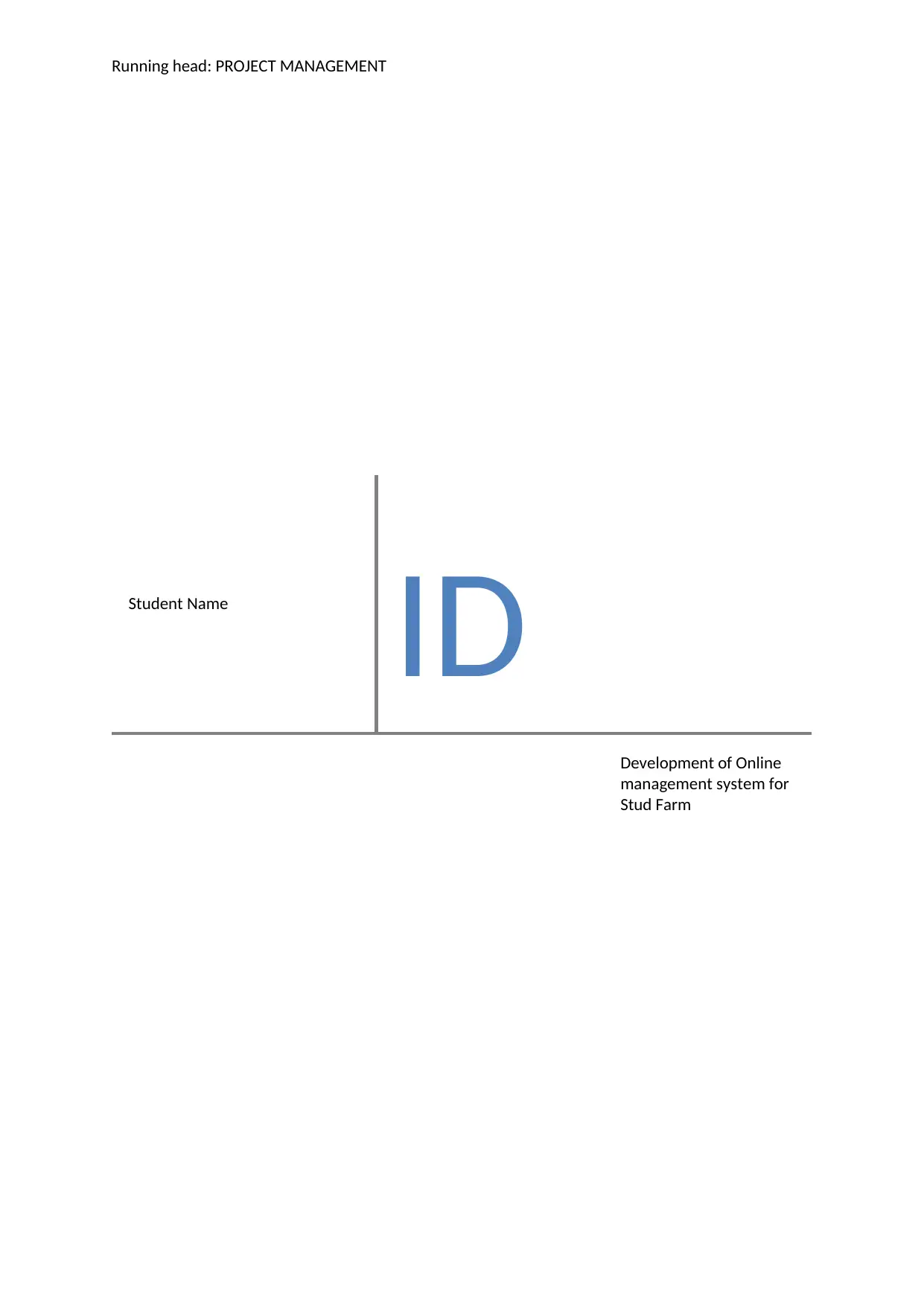
Running head: PROJECT MANAGEMENT
Student Name
ID Development of Online
management system for
Stud Farm
Student Name
ID Development of Online
management system for
Stud Farm
Secure Best Marks with AI Grader
Need help grading? Try our AI Grader for instant feedback on your assignments.
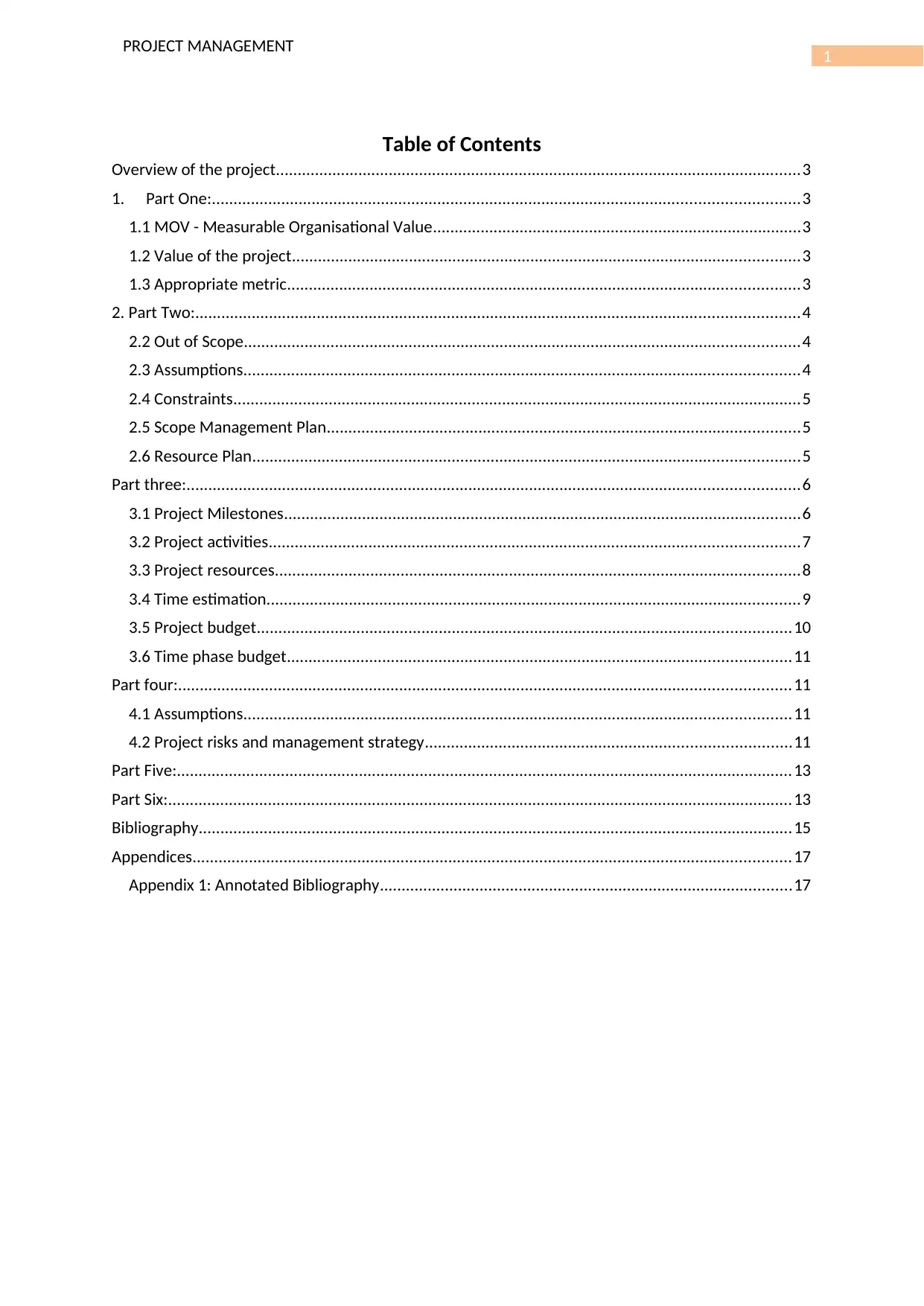
1
PROJECT MANAGEMENT
Table of Contents
Overview of the project.........................................................................................................................3
1. Part One:.......................................................................................................................................3
1.1 MOV - Measurable Organisational Value.....................................................................................3
1.2 Value of the project.....................................................................................................................3
1.3 Appropriate metric......................................................................................................................3
2. Part Two:...........................................................................................................................................4
2.2 Out of Scope................................................................................................................................4
2.3 Assumptions................................................................................................................................4
2.4 Constraints...................................................................................................................................5
2.5 Scope Management Plan.............................................................................................................5
2.6 Resource Plan..............................................................................................................................5
Part three:.............................................................................................................................................6
3.1 Project Milestones.......................................................................................................................6
3.2 Project activities..........................................................................................................................7
3.3 Project resources.........................................................................................................................8
3.4 Time estimation...........................................................................................................................9
3.5 Project budget...........................................................................................................................10
3.6 Time phase budget....................................................................................................................11
Part four:.............................................................................................................................................11
4.1 Assumptions..............................................................................................................................11
4.2 Project risks and management strategy....................................................................................11
Part Five:..............................................................................................................................................13
Part Six:................................................................................................................................................13
Bibliography.........................................................................................................................................15
Appendices..........................................................................................................................................17
Appendix 1: Annotated Bibliography...............................................................................................17
PROJECT MANAGEMENT
Table of Contents
Overview of the project.........................................................................................................................3
1. Part One:.......................................................................................................................................3
1.1 MOV - Measurable Organisational Value.....................................................................................3
1.2 Value of the project.....................................................................................................................3
1.3 Appropriate metric......................................................................................................................3
2. Part Two:...........................................................................................................................................4
2.2 Out of Scope................................................................................................................................4
2.3 Assumptions................................................................................................................................4
2.4 Constraints...................................................................................................................................5
2.5 Scope Management Plan.............................................................................................................5
2.6 Resource Plan..............................................................................................................................5
Part three:.............................................................................................................................................6
3.1 Project Milestones.......................................................................................................................6
3.2 Project activities..........................................................................................................................7
3.3 Project resources.........................................................................................................................8
3.4 Time estimation...........................................................................................................................9
3.5 Project budget...........................................................................................................................10
3.6 Time phase budget....................................................................................................................11
Part four:.............................................................................................................................................11
4.1 Assumptions..............................................................................................................................11
4.2 Project risks and management strategy....................................................................................11
Part Five:..............................................................................................................................................13
Part Six:................................................................................................................................................13
Bibliography.........................................................................................................................................15
Appendices..........................................................................................................................................17
Appendix 1: Annotated Bibliography...............................................................................................17
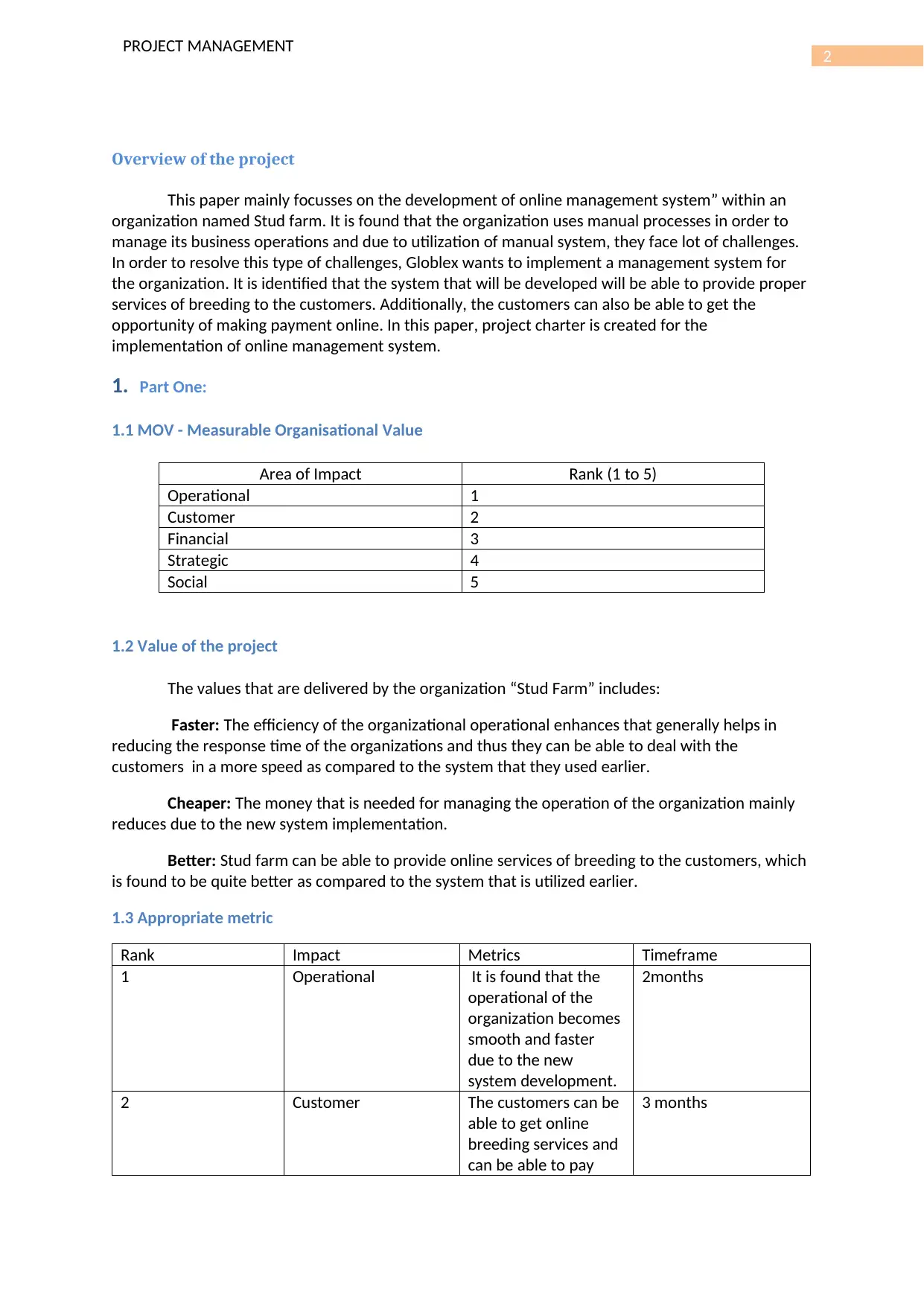
2
PROJECT MANAGEMENT
Overview of the project
This paper mainly focusses on the development of online management system” within an
organization named Stud farm. It is found that the organization uses manual processes in order to
manage its business operations and due to utilization of manual system, they face lot of challenges.
In order to resolve this type of challenges, Globlex wants to implement a management system for
the organization. It is identified that the system that will be developed will be able to provide proper
services of breeding to the customers. Additionally, the customers can also be able to get the
opportunity of making payment online. In this paper, project charter is created for the
implementation of online management system.
1. Part One:
1.1 MOV - Measurable Organisational Value
Area of Impact Rank (1 to 5)
Operational 1
Customer 2
Financial 3
Strategic 4
Social 5
1.2 Value of the project
The values that are delivered by the organization “Stud Farm” includes:
Faster: The efficiency of the organizational operational enhances that generally helps in
reducing the response time of the organizations and thus they can be able to deal with the
customers in a more speed as compared to the system that they used earlier.
Cheaper: The money that is needed for managing the operation of the organization mainly
reduces due to the new system implementation.
Better: Stud farm can be able to provide online services of breeding to the customers, which
is found to be quite better as compared to the system that is utilized earlier.
1.3 Appropriate metric
Rank Impact Metrics Timeframe
1 Operational It is found that the
operational of the
organization becomes
smooth and faster
due to the new
system development.
2months
2 Customer The customers can be
able to get online
breeding services and
can be able to pay
3 months
PROJECT MANAGEMENT
Overview of the project
This paper mainly focusses on the development of online management system” within an
organization named Stud farm. It is found that the organization uses manual processes in order to
manage its business operations and due to utilization of manual system, they face lot of challenges.
In order to resolve this type of challenges, Globlex wants to implement a management system for
the organization. It is identified that the system that will be developed will be able to provide proper
services of breeding to the customers. Additionally, the customers can also be able to get the
opportunity of making payment online. In this paper, project charter is created for the
implementation of online management system.
1. Part One:
1.1 MOV - Measurable Organisational Value
Area of Impact Rank (1 to 5)
Operational 1
Customer 2
Financial 3
Strategic 4
Social 5
1.2 Value of the project
The values that are delivered by the organization “Stud Farm” includes:
Faster: The efficiency of the organizational operational enhances that generally helps in
reducing the response time of the organizations and thus they can be able to deal with the
customers in a more speed as compared to the system that they used earlier.
Cheaper: The money that is needed for managing the operation of the organization mainly
reduces due to the new system implementation.
Better: Stud farm can be able to provide online services of breeding to the customers, which
is found to be quite better as compared to the system that is utilized earlier.
1.3 Appropriate metric
Rank Impact Metrics Timeframe
1 Operational It is found that the
operational of the
organization becomes
smooth and faster
due to the new
system development.
2months
2 Customer The customers can be
able to get online
breeding services and
can be able to pay
3 months
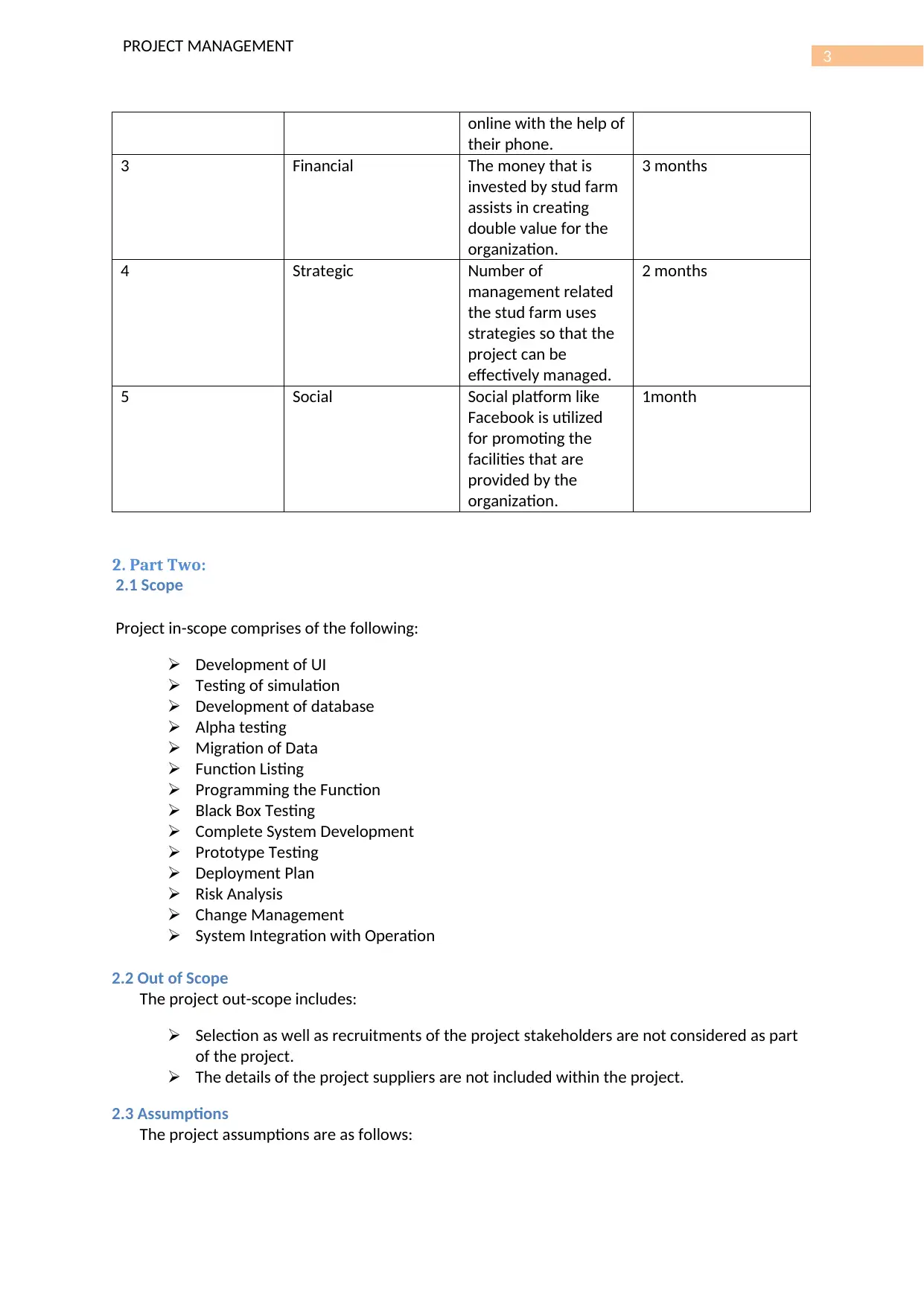
3
PROJECT MANAGEMENT
online with the help of
their phone.
3 Financial The money that is
invested by stud farm
assists in creating
double value for the
organization.
3 months
4 Strategic Number of
management related
the stud farm uses
strategies so that the
project can be
effectively managed.
2 months
5 Social Social platform like
Facebook is utilized
for promoting the
facilities that are
provided by the
organization.
1month
2. Part Two:
2.1 Scope
Project in-scope comprises of the following:
Development of UI
Testing of simulation
Development of database
Alpha testing
Migration of Data
Function Listing
Programming the Function
Black Box Testing
Complete System Development
Prototype Testing
Deployment Plan
Risk Analysis
Change Management
System Integration with Operation
2.2 Out of Scope
The project out-scope includes:
Selection as well as recruitments of the project stakeholders are not considered as part
of the project.
The details of the project suppliers are not included within the project.
2.3 Assumptions
The project assumptions are as follows:
PROJECT MANAGEMENT
online with the help of
their phone.
3 Financial The money that is
invested by stud farm
assists in creating
double value for the
organization.
3 months
4 Strategic Number of
management related
the stud farm uses
strategies so that the
project can be
effectively managed.
2 months
5 Social Social platform like
Facebook is utilized
for promoting the
facilities that are
provided by the
organization.
1month
2. Part Two:
2.1 Scope
Project in-scope comprises of the following:
Development of UI
Testing of simulation
Development of database
Alpha testing
Migration of Data
Function Listing
Programming the Function
Black Box Testing
Complete System Development
Prototype Testing
Deployment Plan
Risk Analysis
Change Management
System Integration with Operation
2.2 Out of Scope
The project out-scope includes:
Selection as well as recruitments of the project stakeholders are not considered as part
of the project.
The details of the project suppliers are not included within the project.
2.3 Assumptions
The project assumptions are as follows:
Secure Best Marks with AI Grader
Need help grading? Try our AI Grader for instant feedback on your assignments.
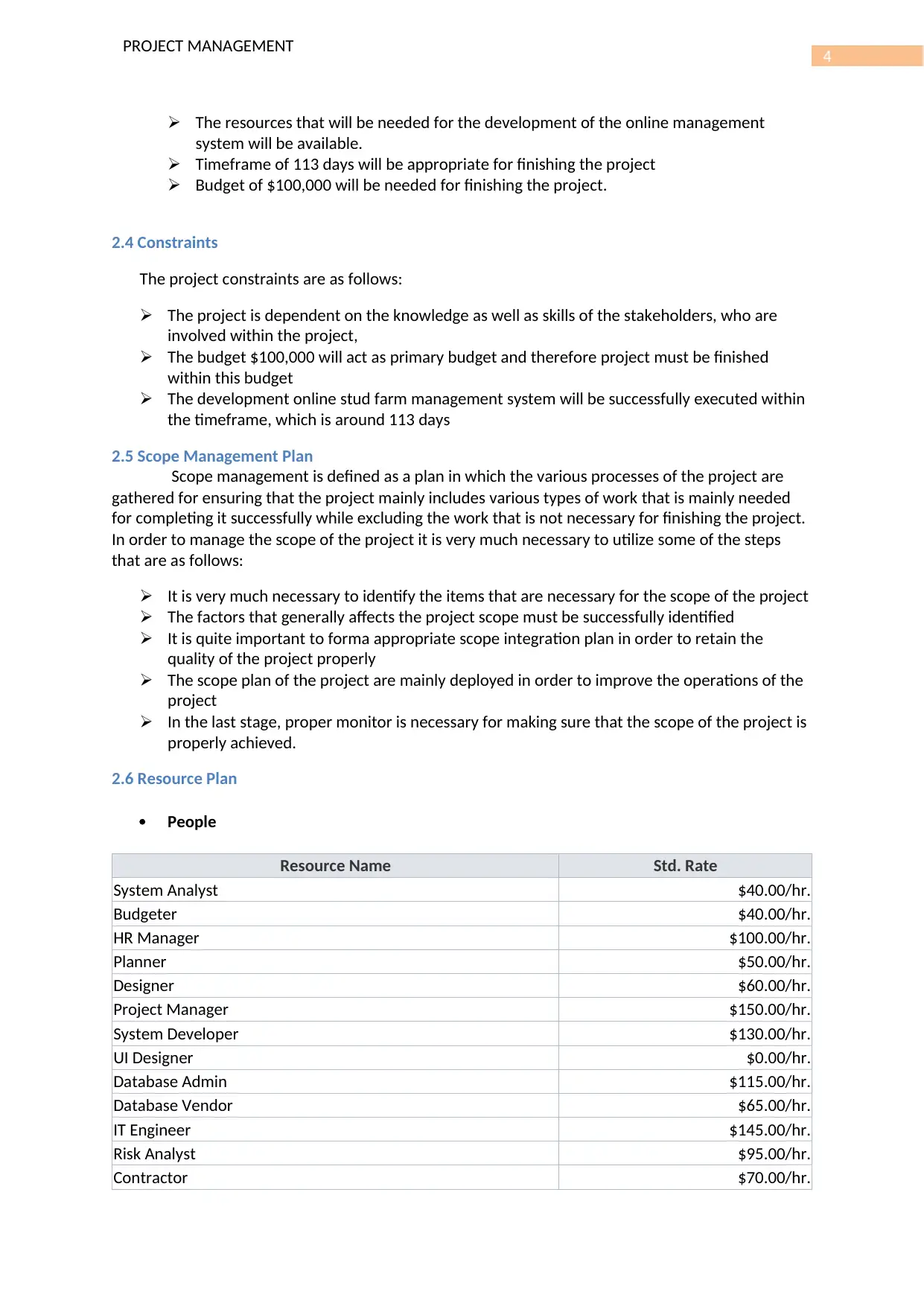
4
PROJECT MANAGEMENT
The resources that will be needed for the development of the online management
system will be available.
Timeframe of 113 days will be appropriate for finishing the project
Budget of $100,000 will be needed for finishing the project.
2.4 Constraints
The project constraints are as follows:
The project is dependent on the knowledge as well as skills of the stakeholders, who are
involved within the project,
The budget $100,000 will act as primary budget and therefore project must be finished
within this budget
The development online stud farm management system will be successfully executed within
the timeframe, which is around 113 days
2.5 Scope Management Plan
Scope management is defined as a plan in which the various processes of the project are
gathered for ensuring that the project mainly includes various types of work that is mainly needed
for completing it successfully while excluding the work that is not necessary for finishing the project.
In order to manage the scope of the project it is very much necessary to utilize some of the steps
that are as follows:
It is very much necessary to identify the items that are necessary for the scope of the project
The factors that generally affects the project scope must be successfully identified
It is quite important to forma appropriate scope integration plan in order to retain the
quality of the project properly
The scope plan of the project are mainly deployed in order to improve the operations of the
project
In the last stage, proper monitor is necessary for making sure that the scope of the project is
properly achieved.
2.6 Resource Plan
People
Resource Name Std. Rate
System Analyst $40.00/hr.
Budgeter $40.00/hr.
HR Manager $100.00/hr.
Planner $50.00/hr.
Designer $60.00/hr.
Project Manager $150.00/hr.
System Developer $130.00/hr.
UI Designer $0.00/hr.
Database Admin $115.00/hr.
Database Vendor $65.00/hr.
IT Engineer $145.00/hr.
Risk Analyst $95.00/hr.
Contractor $70.00/hr.
PROJECT MANAGEMENT
The resources that will be needed for the development of the online management
system will be available.
Timeframe of 113 days will be appropriate for finishing the project
Budget of $100,000 will be needed for finishing the project.
2.4 Constraints
The project constraints are as follows:
The project is dependent on the knowledge as well as skills of the stakeholders, who are
involved within the project,
The budget $100,000 will act as primary budget and therefore project must be finished
within this budget
The development online stud farm management system will be successfully executed within
the timeframe, which is around 113 days
2.5 Scope Management Plan
Scope management is defined as a plan in which the various processes of the project are
gathered for ensuring that the project mainly includes various types of work that is mainly needed
for completing it successfully while excluding the work that is not necessary for finishing the project.
In order to manage the scope of the project it is very much necessary to utilize some of the steps
that are as follows:
It is very much necessary to identify the items that are necessary for the scope of the project
The factors that generally affects the project scope must be successfully identified
It is quite important to forma appropriate scope integration plan in order to retain the
quality of the project properly
The scope plan of the project are mainly deployed in order to improve the operations of the
project
In the last stage, proper monitor is necessary for making sure that the scope of the project is
properly achieved.
2.6 Resource Plan
People
Resource Name Std. Rate
System Analyst $40.00/hr.
Budgeter $40.00/hr.
HR Manager $100.00/hr.
Planner $50.00/hr.
Designer $60.00/hr.
Project Manager $150.00/hr.
System Developer $130.00/hr.
UI Designer $0.00/hr.
Database Admin $115.00/hr.
Database Vendor $65.00/hr.
IT Engineer $145.00/hr.
Risk Analyst $95.00/hr.
Contractor $70.00/hr.
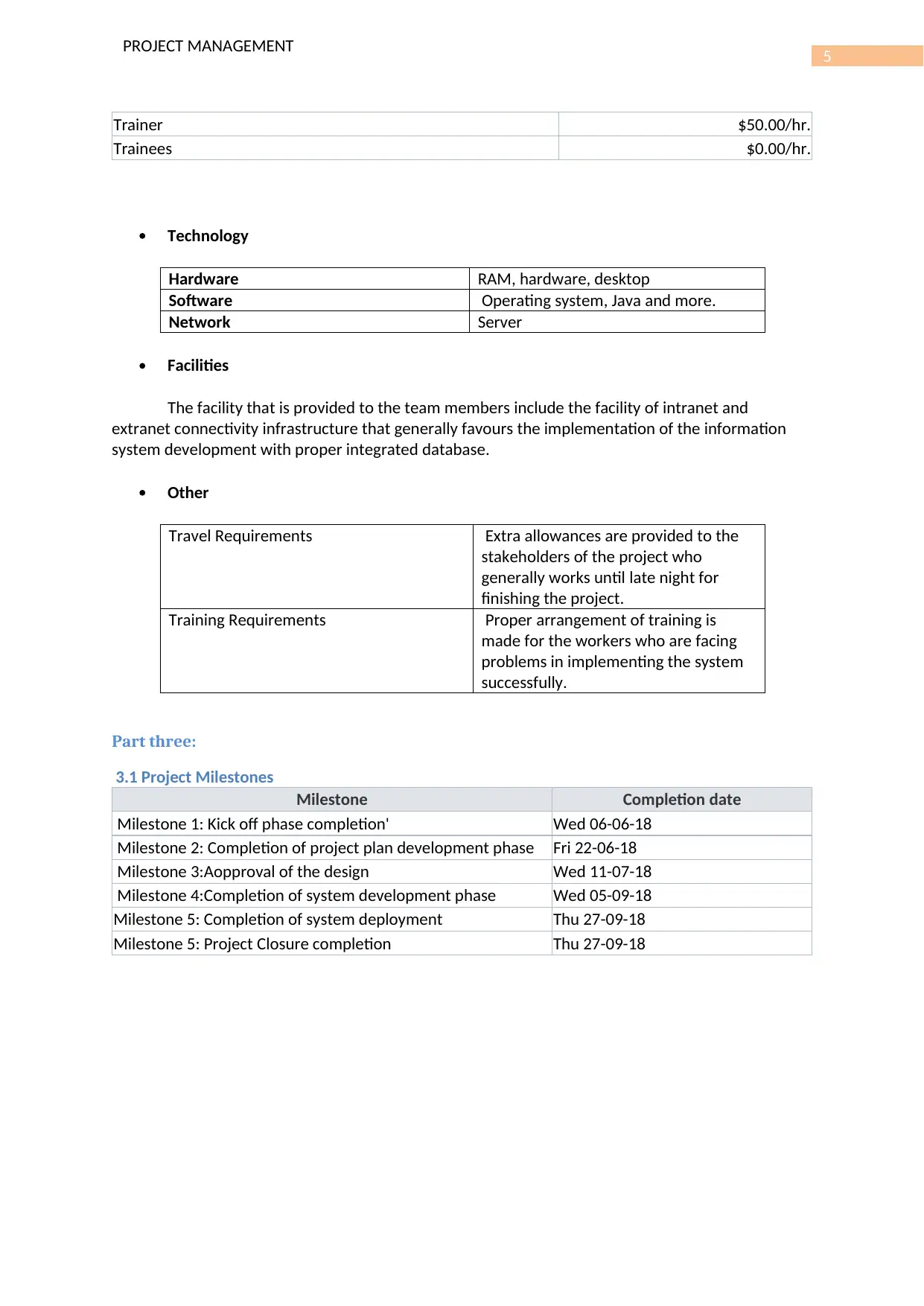
5
PROJECT MANAGEMENT
Trainer $50.00/hr.
Trainees $0.00/hr.
Technology
Hardware RAM, hardware, desktop
Software Operating system, Java and more.
Network Server
Facilities
The facility that is provided to the team members include the facility of intranet and
extranet connectivity infrastructure that generally favours the implementation of the information
system development with proper integrated database.
Other
Travel Requirements Extra allowances are provided to the
stakeholders of the project who
generally works until late night for
finishing the project.
Training Requirements Proper arrangement of training is
made for the workers who are facing
problems in implementing the system
successfully.
Part three:
3.1 Project Milestones
Milestone Completion date
Milestone 1: Kick off phase completion' Wed 06-06-18
Milestone 2: Completion of project plan development phase Fri 22-06-18
Milestone 3:Aopproval of the design Wed 11-07-18
Milestone 4:Completion of system development phase Wed 05-09-18
Milestone 5: Completion of system deployment Thu 27-09-18
Milestone 5: Project Closure completion Thu 27-09-18
PROJECT MANAGEMENT
Trainer $50.00/hr.
Trainees $0.00/hr.
Technology
Hardware RAM, hardware, desktop
Software Operating system, Java and more.
Network Server
Facilities
The facility that is provided to the team members include the facility of intranet and
extranet connectivity infrastructure that generally favours the implementation of the information
system development with proper integrated database.
Other
Travel Requirements Extra allowances are provided to the
stakeholders of the project who
generally works until late night for
finishing the project.
Training Requirements Proper arrangement of training is
made for the workers who are facing
problems in implementing the system
successfully.
Part three:
3.1 Project Milestones
Milestone Completion date
Milestone 1: Kick off phase completion' Wed 06-06-18
Milestone 2: Completion of project plan development phase Fri 22-06-18
Milestone 3:Aopproval of the design Wed 11-07-18
Milestone 4:Completion of system development phase Wed 05-09-18
Milestone 5: Completion of system deployment Thu 27-09-18
Milestone 5: Project Closure completion Thu 27-09-18
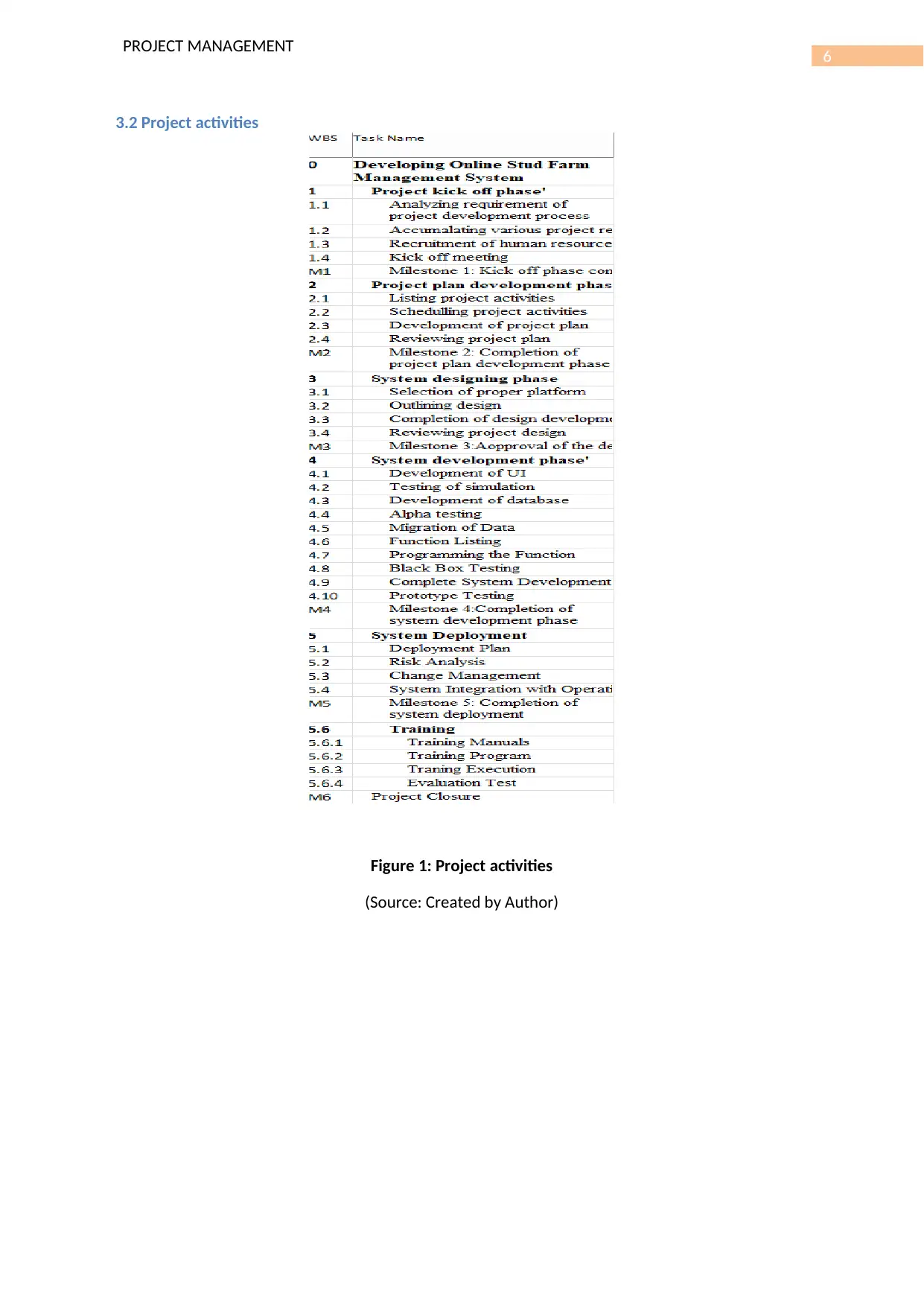
6
PROJECT MANAGEMENT
3.2 Project activities
Figure 1: Project activities
(Source: Created by Author)
PROJECT MANAGEMENT
3.2 Project activities
Figure 1: Project activities
(Source: Created by Author)
Paraphrase This Document
Need a fresh take? Get an instant paraphrase of this document with our AI Paraphraser
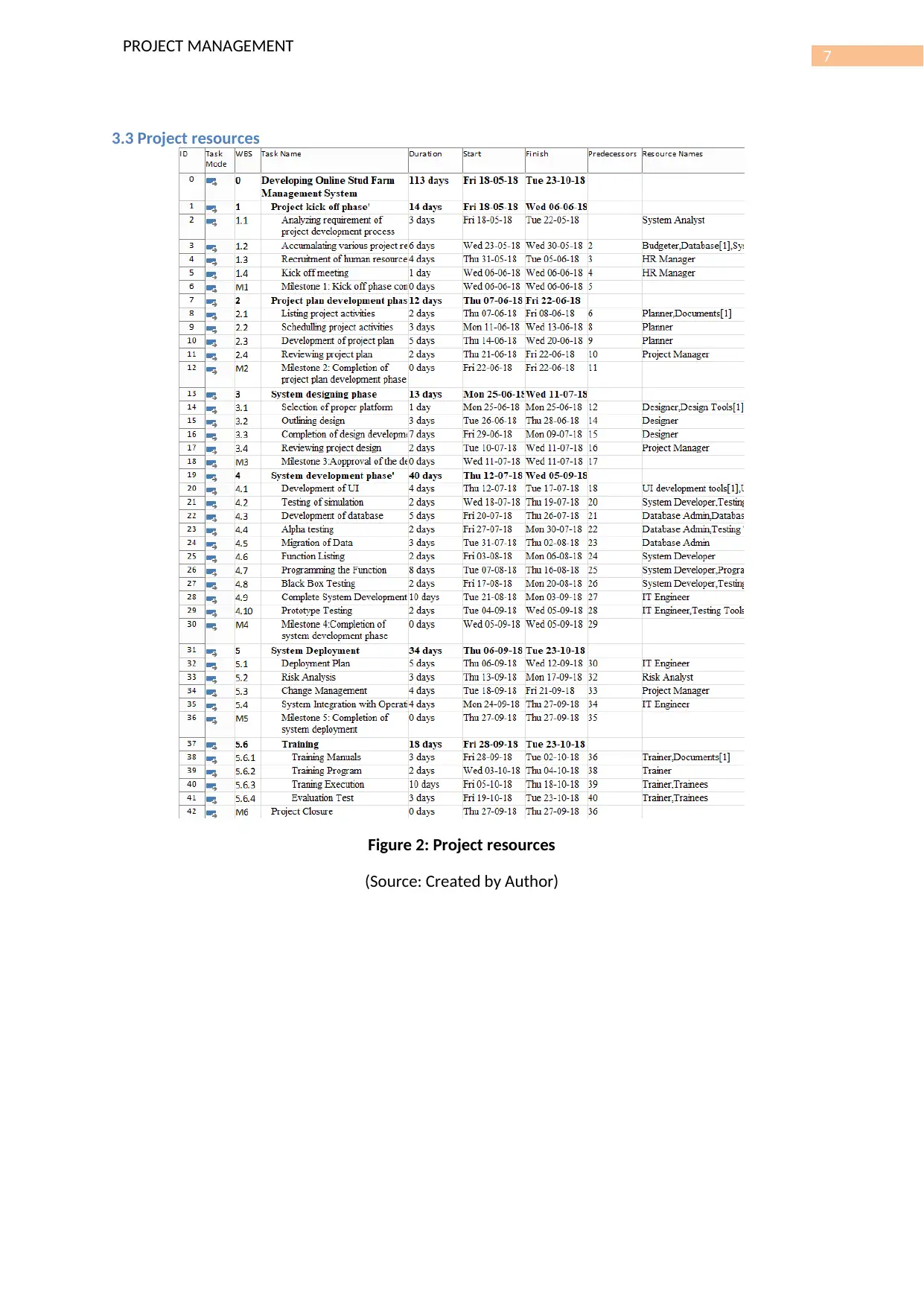
7
PROJECT MANAGEMENT
3.3 Project resources
Figure 2: Project resources
(Source: Created by Author)
PROJECT MANAGEMENT
3.3 Project resources
Figure 2: Project resources
(Source: Created by Author)
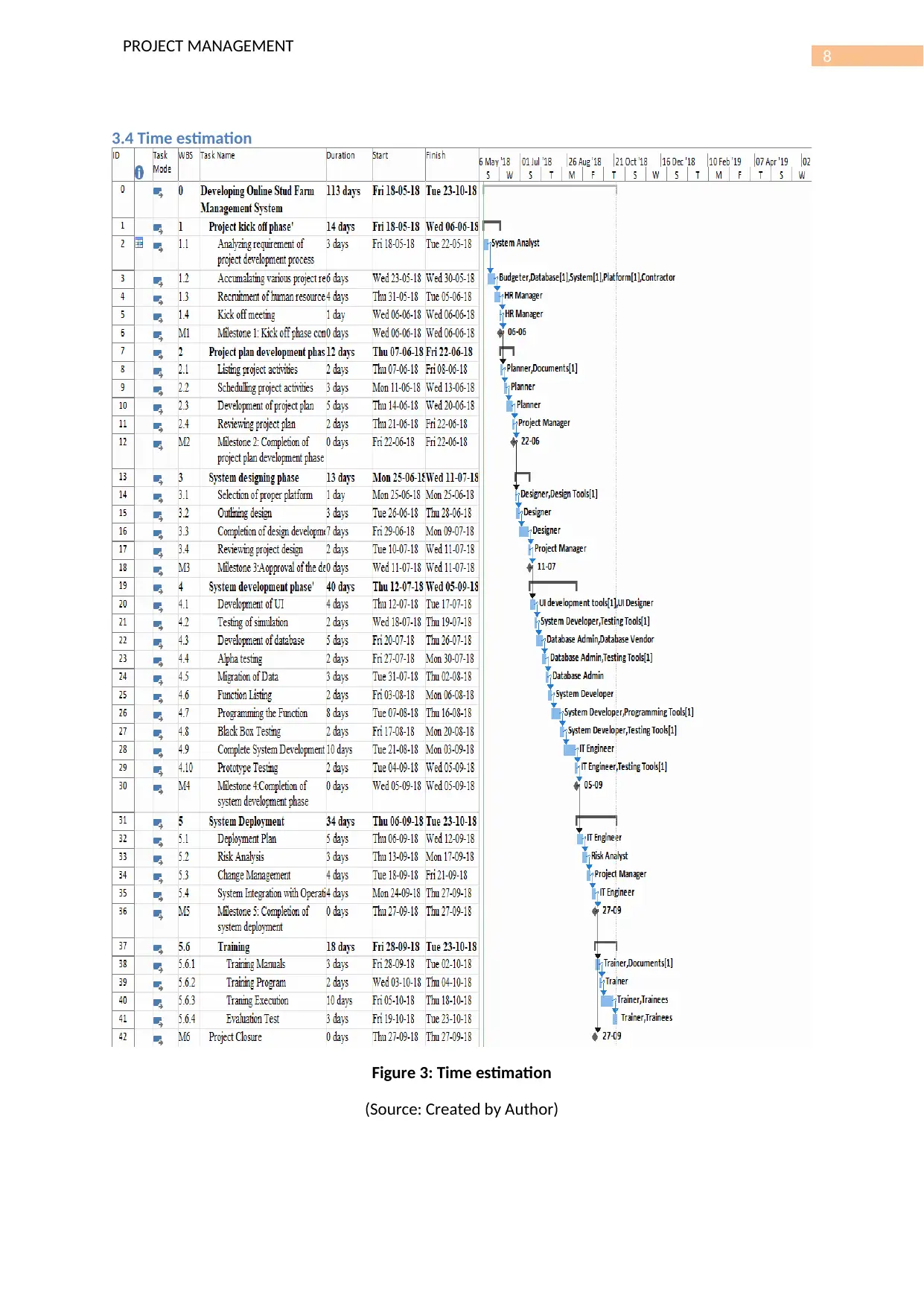
8
PROJECT MANAGEMENT
3.4 Time estimation
Figure 3: Time estimation
(Source: Created by Author)
PROJECT MANAGEMENT
3.4 Time estimation
Figure 3: Time estimation
(Source: Created by Author)
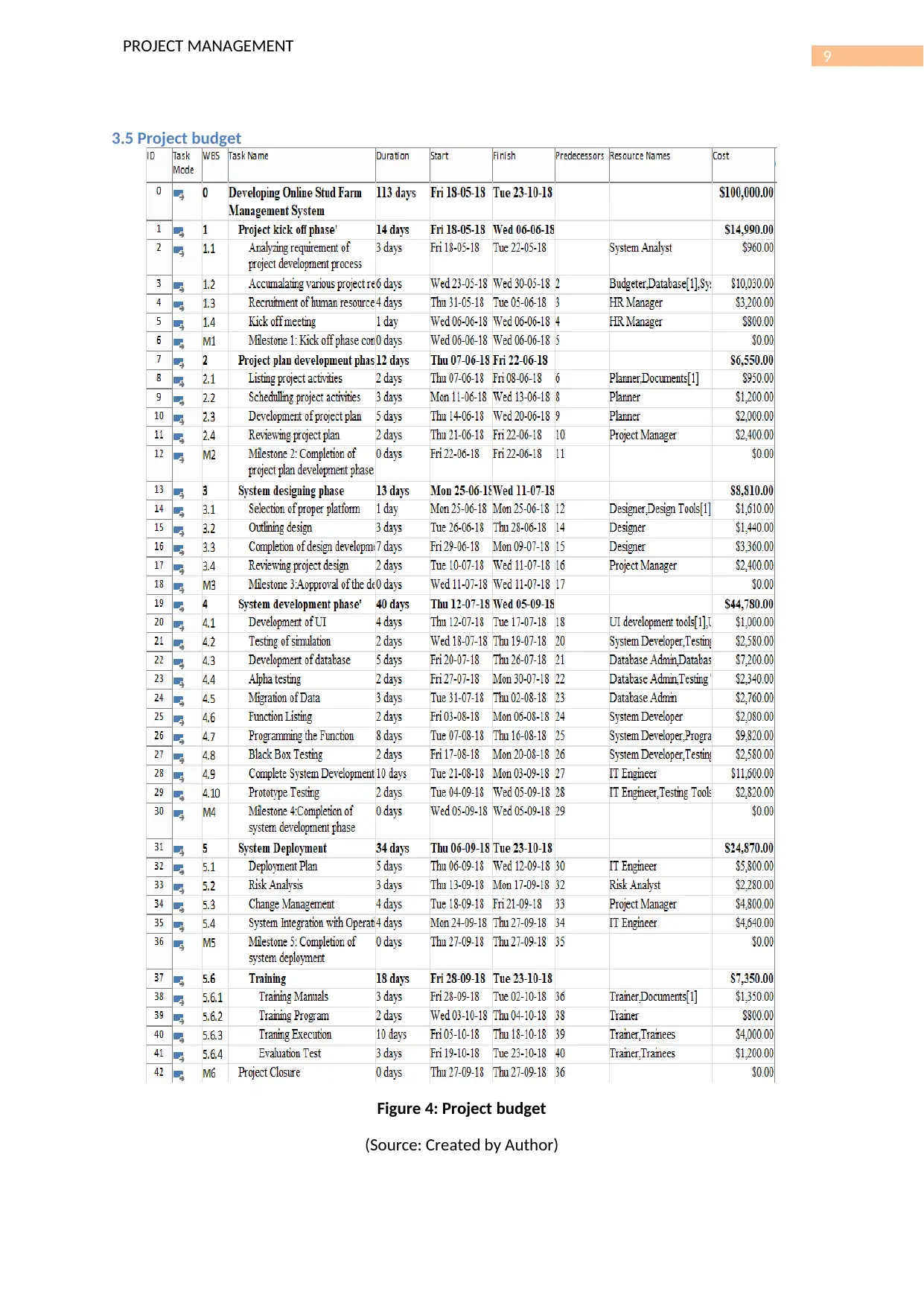
9
PROJECT MANAGEMENT
3.5 Project budget
Figure 4: Project budget
(Source: Created by Author)
PROJECT MANAGEMENT
3.5 Project budget
Figure 4: Project budget
(Source: Created by Author)
Secure Best Marks with AI Grader
Need help grading? Try our AI Grader for instant feedback on your assignments.
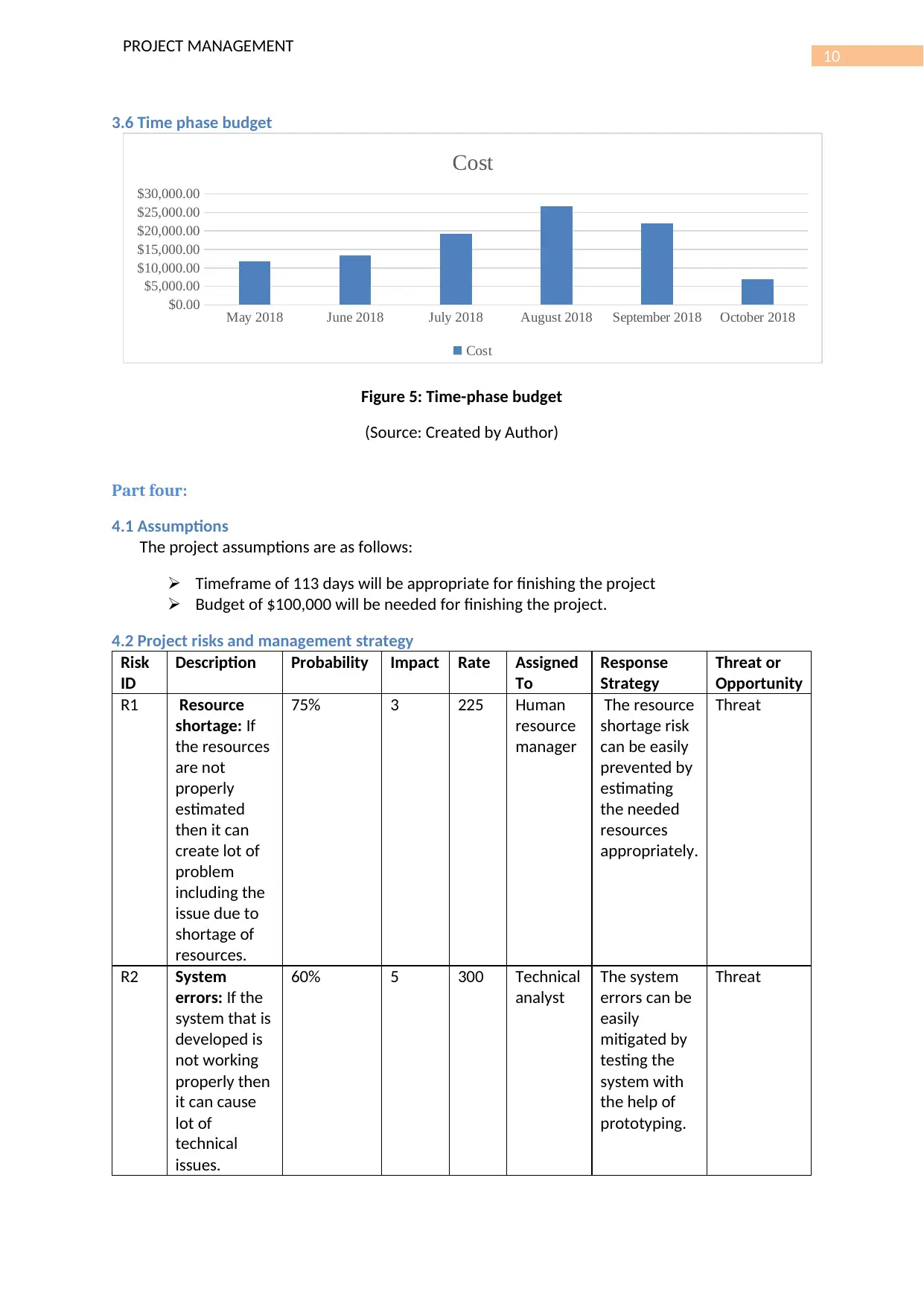
10
PROJECT MANAGEMENT
3.6 Time phase budget
May 2018 June 2018 July 2018 August 2018 September 2018 October 2018
$0.00
$5,000.00
$10,000.00
$15,000.00
$20,000.00
$25,000.00
$30,000.00
Cost
Cost
Figure 5: Time-phase budget
(Source: Created by Author)
Part four:
4.1 Assumptions
The project assumptions are as follows:
Timeframe of 113 days will be appropriate for finishing the project
Budget of $100,000 will be needed for finishing the project.
4.2 Project risks and management strategy
Risk
ID
Description Probability Impact Rate Assigned
To
Response
Strategy
Threat or
Opportunity
R1 Resource
shortage: If
the resources
are not
properly
estimated
then it can
create lot of
problem
including the
issue due to
shortage of
resources.
75% 3 225 Human
resource
manager
The resource
shortage risk
can be easily
prevented by
estimating
the needed
resources
appropriately.
Threat
R2 System
errors: If the
system that is
developed is
not working
properly then
it can cause
lot of
technical
issues.
60% 5 300 Technical
analyst
The system
errors can be
easily
mitigated by
testing the
system with
the help of
prototyping.
Threat
PROJECT MANAGEMENT
3.6 Time phase budget
May 2018 June 2018 July 2018 August 2018 September 2018 October 2018
$0.00
$5,000.00
$10,000.00
$15,000.00
$20,000.00
$25,000.00
$30,000.00
Cost
Cost
Figure 5: Time-phase budget
(Source: Created by Author)
Part four:
4.1 Assumptions
The project assumptions are as follows:
Timeframe of 113 days will be appropriate for finishing the project
Budget of $100,000 will be needed for finishing the project.
4.2 Project risks and management strategy
Risk
ID
Description Probability Impact Rate Assigned
To
Response
Strategy
Threat or
Opportunity
R1 Resource
shortage: If
the resources
are not
properly
estimated
then it can
create lot of
problem
including the
issue due to
shortage of
resources.
75% 3 225 Human
resource
manager
The resource
shortage risk
can be easily
prevented by
estimating
the needed
resources
appropriately.
Threat
R2 System
errors: If the
system that is
developed is
not working
properly then
it can cause
lot of
technical
issues.
60% 5 300 Technical
analyst
The system
errors can be
easily
mitigated by
testing the
system with
the help of
prototyping.
Threat
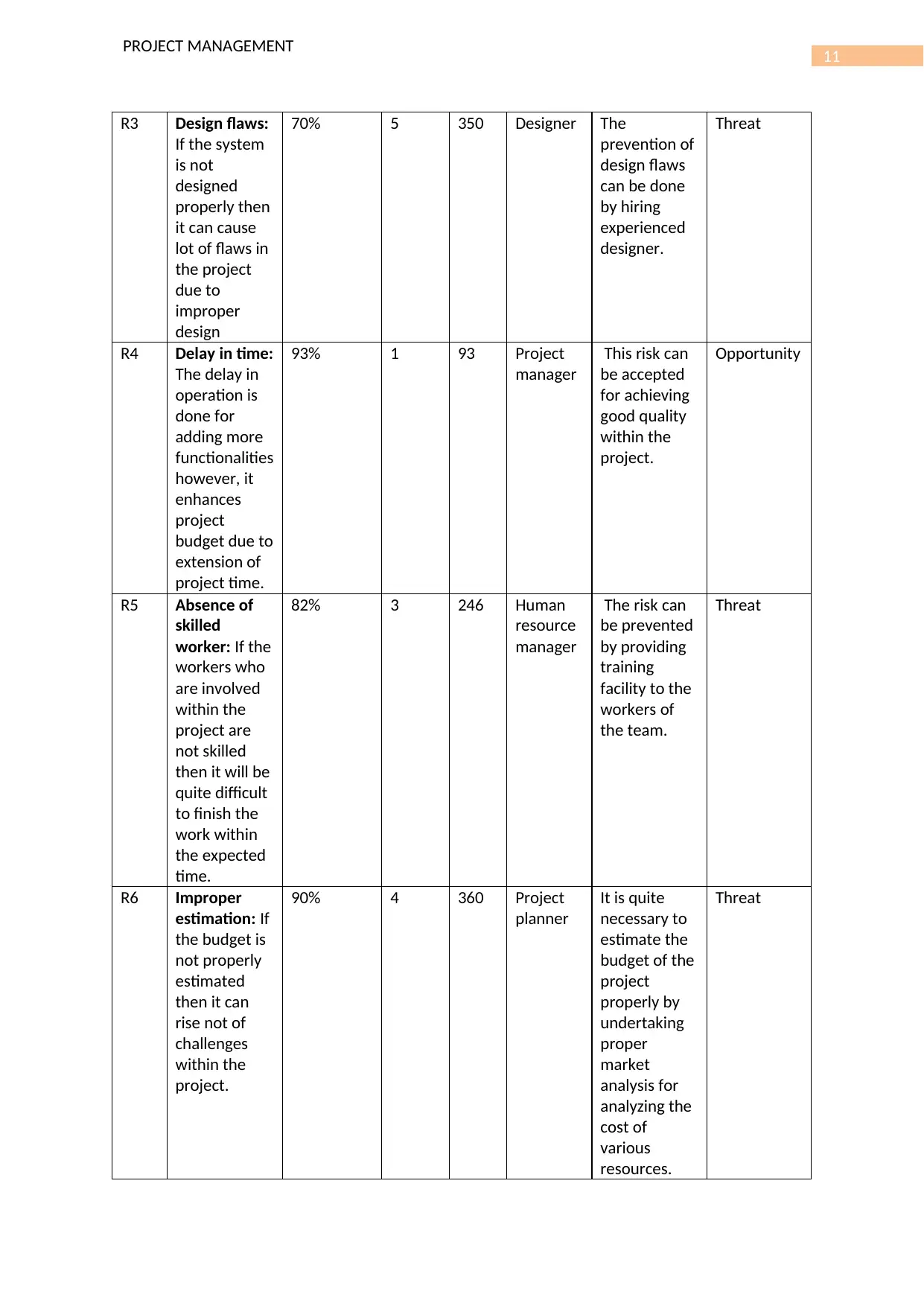
11
PROJECT MANAGEMENT
R3 Design flaws:
If the system
is not
designed
properly then
it can cause
lot of flaws in
the project
due to
improper
design
70% 5 350 Designer The
prevention of
design flaws
can be done
by hiring
experienced
designer.
Threat
R4 Delay in time:
The delay in
operation is
done for
adding more
functionalities
however, it
enhances
project
budget due to
extension of
project time.
93% 1 93 Project
manager
This risk can
be accepted
for achieving
good quality
within the
project.
Opportunity
R5 Absence of
skilled
worker: If the
workers who
are involved
within the
project are
not skilled
then it will be
quite difficult
to finish the
work within
the expected
time.
82% 3 246 Human
resource
manager
The risk can
be prevented
by providing
training
facility to the
workers of
the team.
Threat
R6 Improper
estimation: If
the budget is
not properly
estimated
then it can
rise not of
challenges
within the
project.
90% 4 360 Project
planner
It is quite
necessary to
estimate the
budget of the
project
properly by
undertaking
proper
market
analysis for
analyzing the
cost of
various
resources.
Threat
PROJECT MANAGEMENT
R3 Design flaws:
If the system
is not
designed
properly then
it can cause
lot of flaws in
the project
due to
improper
design
70% 5 350 Designer The
prevention of
design flaws
can be done
by hiring
experienced
designer.
Threat
R4 Delay in time:
The delay in
operation is
done for
adding more
functionalities
however, it
enhances
project
budget due to
extension of
project time.
93% 1 93 Project
manager
This risk can
be accepted
for achieving
good quality
within the
project.
Opportunity
R5 Absence of
skilled
worker: If the
workers who
are involved
within the
project are
not skilled
then it will be
quite difficult
to finish the
work within
the expected
time.
82% 3 246 Human
resource
manager
The risk can
be prevented
by providing
training
facility to the
workers of
the team.
Threat
R6 Improper
estimation: If
the budget is
not properly
estimated
then it can
rise not of
challenges
within the
project.
90% 4 360 Project
planner
It is quite
necessary to
estimate the
budget of the
project
properly by
undertaking
proper
market
analysis for
analyzing the
cost of
various
resources.
Threat
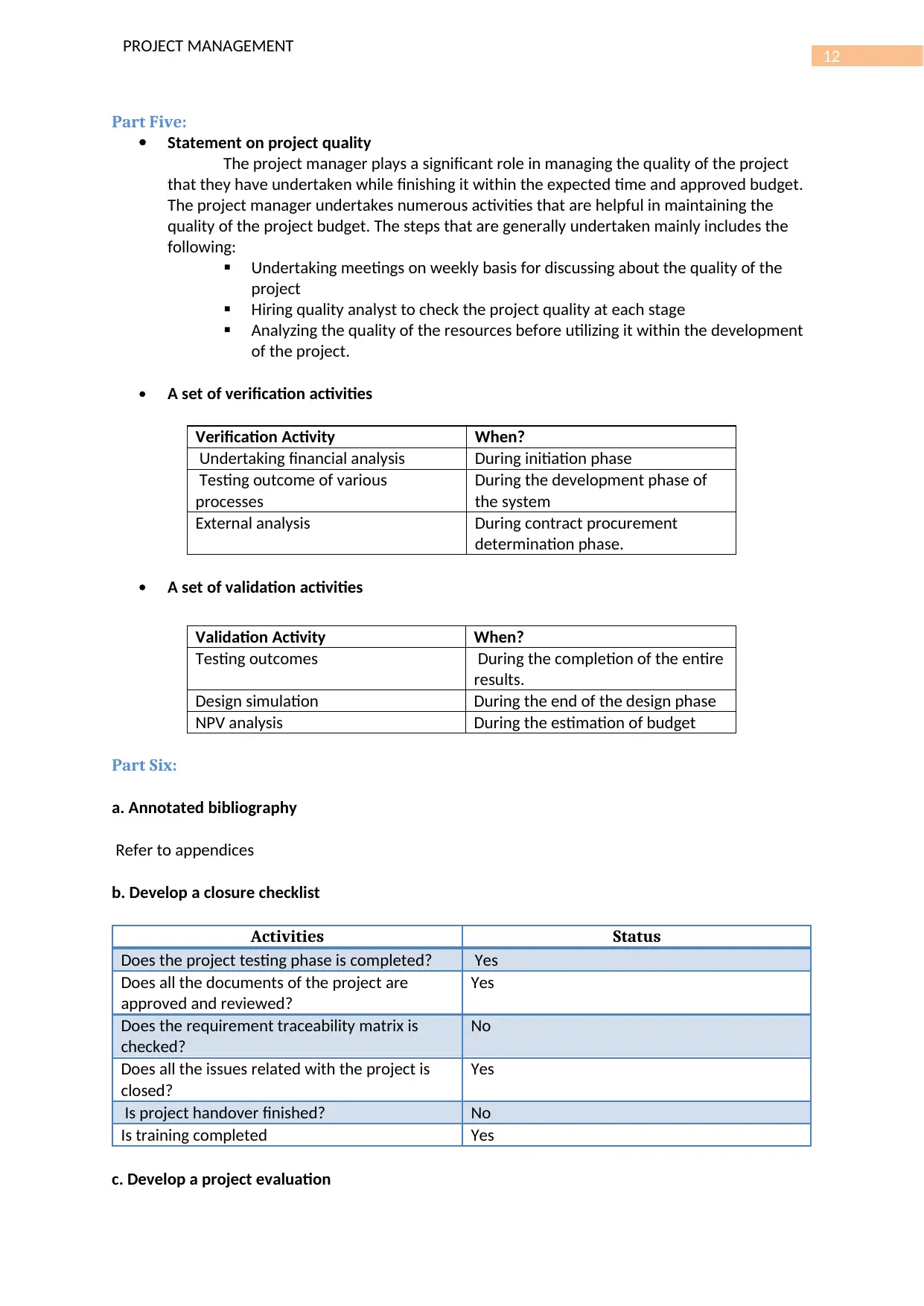
12
PROJECT MANAGEMENT
Part Five:
Statement on project quality
The project manager plays a significant role in managing the quality of the project
that they have undertaken while finishing it within the expected time and approved budget.
The project manager undertakes numerous activities that are helpful in maintaining the
quality of the project budget. The steps that are generally undertaken mainly includes the
following:
Undertaking meetings on weekly basis for discussing about the quality of the
project
Hiring quality analyst to check the project quality at each stage
Analyzing the quality of the resources before utilizing it within the development
of the project.
A set of verification activities
Verification Activity When?
Undertaking financial analysis During initiation phase
Testing outcome of various
processes
During the development phase of
the system
External analysis During contract procurement
determination phase.
A set of validation activities
Part Six:
a. Annotated bibliography
Refer to appendices
b. Develop a closure checklist
Activities Status
Does the project testing phase is completed? Yes
Does all the documents of the project are
approved and reviewed?
Yes
Does the requirement traceability matrix is
checked?
No
Does all the issues related with the project is
closed?
Yes
Is project handover finished? No
Is training completed Yes
c. Develop a project evaluation
Validation Activity When?
Testing outcomes During the completion of the entire
results.
Design simulation During the end of the design phase
NPV analysis During the estimation of budget
PROJECT MANAGEMENT
Part Five:
Statement on project quality
The project manager plays a significant role in managing the quality of the project
that they have undertaken while finishing it within the expected time and approved budget.
The project manager undertakes numerous activities that are helpful in maintaining the
quality of the project budget. The steps that are generally undertaken mainly includes the
following:
Undertaking meetings on weekly basis for discussing about the quality of the
project
Hiring quality analyst to check the project quality at each stage
Analyzing the quality of the resources before utilizing it within the development
of the project.
A set of verification activities
Verification Activity When?
Undertaking financial analysis During initiation phase
Testing outcome of various
processes
During the development phase of
the system
External analysis During contract procurement
determination phase.
A set of validation activities
Part Six:
a. Annotated bibliography
Refer to appendices
b. Develop a closure checklist
Activities Status
Does the project testing phase is completed? Yes
Does all the documents of the project are
approved and reviewed?
Yes
Does the requirement traceability matrix is
checked?
No
Does all the issues related with the project is
closed?
Yes
Is project handover finished? No
Is training completed Yes
c. Develop a project evaluation
Validation Activity When?
Testing outcomes During the completion of the entire
results.
Design simulation During the end of the design phase
NPV analysis During the estimation of budget
Paraphrase This Document
Need a fresh take? Get an instant paraphrase of this document with our AI Paraphraser
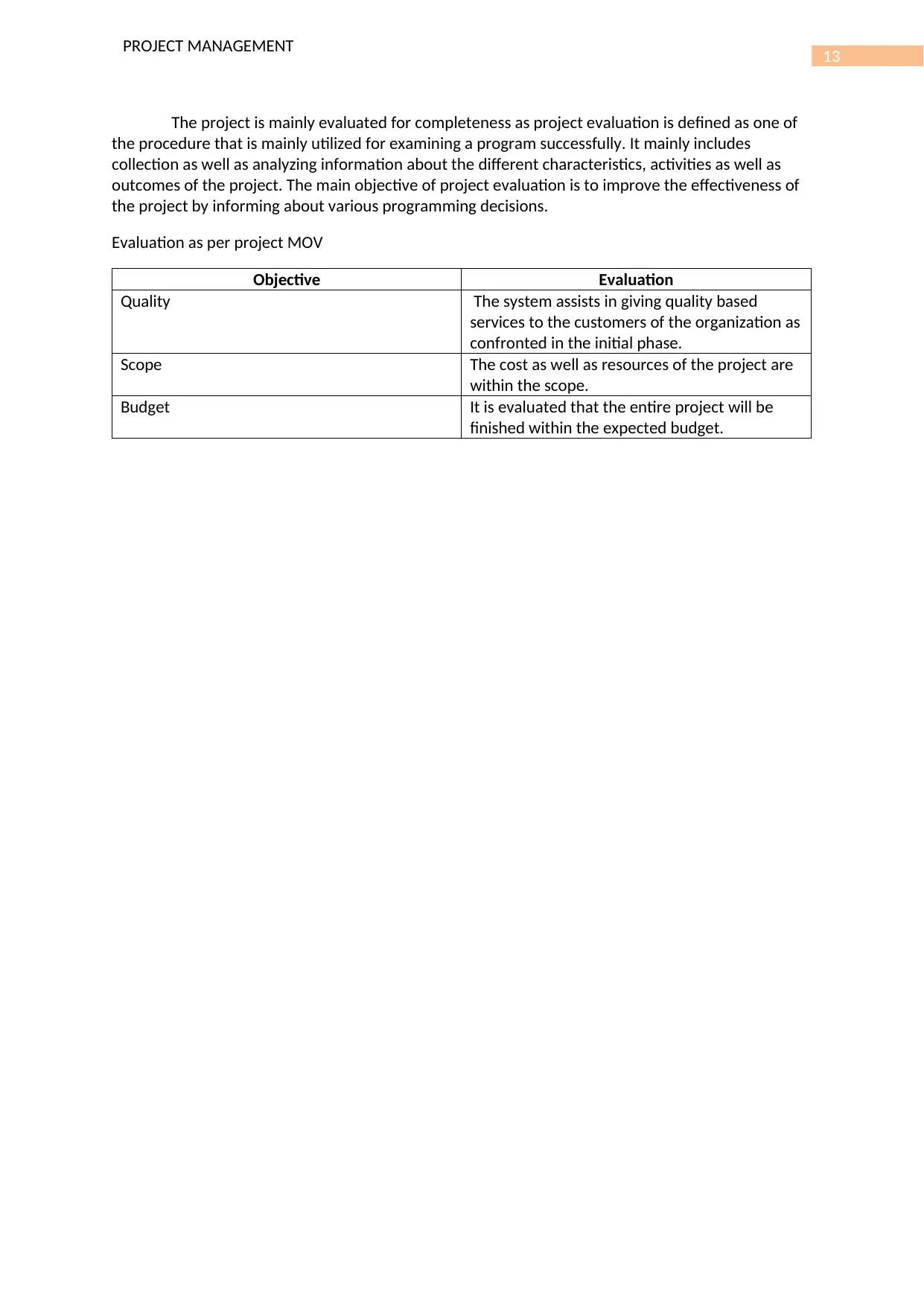
13
PROJECT MANAGEMENT
The project is mainly evaluated for completeness as project evaluation is defined as one of
the procedure that is mainly utilized for examining a program successfully. It mainly includes
collection as well as analyzing information about the different characteristics, activities as well as
outcomes of the project. The main objective of project evaluation is to improve the effectiveness of
the project by informing about various programming decisions.
Evaluation as per project MOV
Objective Evaluation
Quality The system assists in giving quality based
services to the customers of the organization as
confronted in the initial phase.
Scope The cost as well as resources of the project are
within the scope.
Budget It is evaluated that the entire project will be
finished within the expected budget.
PROJECT MANAGEMENT
The project is mainly evaluated for completeness as project evaluation is defined as one of
the procedure that is mainly utilized for examining a program successfully. It mainly includes
collection as well as analyzing information about the different characteristics, activities as well as
outcomes of the project. The main objective of project evaluation is to improve the effectiveness of
the project by informing about various programming decisions.
Evaluation as per project MOV
Objective Evaluation
Quality The system assists in giving quality based
services to the customers of the organization as
confronted in the initial phase.
Scope The cost as well as resources of the project are
within the scope.
Budget It is evaluated that the entire project will be
finished within the expected budget.
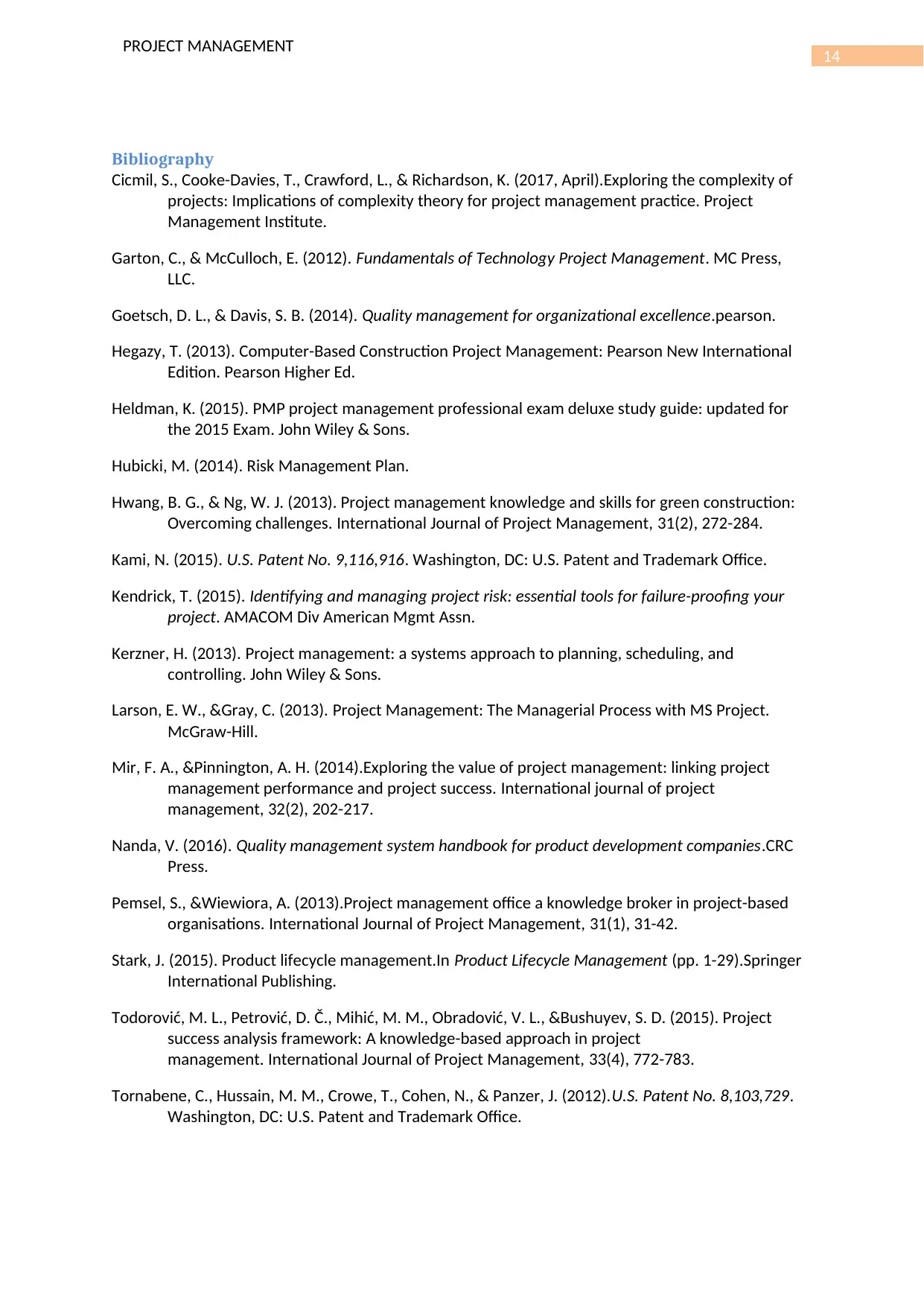
14
PROJECT MANAGEMENT
Bibliography
Cicmil, S., Cooke-Davies, T., Crawford, L., & Richardson, K. (2017, April).Exploring the complexity of
projects: Implications of complexity theory for project management practice. Project
Management Institute.
Garton, C., & McCulloch, E. (2012). Fundamentals of Technology Project Management. MC Press,
LLC.
Goetsch, D. L., & Davis, S. B. (2014). Quality management for organizational excellence.pearson.
Hegazy, T. (2013). Computer-Based Construction Project Management: Pearson New International
Edition. Pearson Higher Ed.
Heldman, K. (2015). PMP project management professional exam deluxe study guide: updated for
the 2015 Exam. John Wiley & Sons.
Hubicki, M. (2014). Risk Management Plan.
Hwang, B. G., & Ng, W. J. (2013). Project management knowledge and skills for green construction:
Overcoming challenges. International Journal of Project Management, 31(2), 272-284.
Kami, N. (2015). U.S. Patent No. 9,116,916. Washington, DC: U.S. Patent and Trademark Office.
Kendrick, T. (2015). Identifying and managing project risk: essential tools for failure-proofing your
project. AMACOM Div American Mgmt Assn.
Kerzner, H. (2013). Project management: a systems approach to planning, scheduling, and
controlling. John Wiley & Sons.
Larson, E. W., &Gray, C. (2013). Project Management: The Managerial Process with MS Project.
McGraw-Hill.
Mir, F. A., &Pinnington, A. H. (2014).Exploring the value of project management: linking project
management performance and project success. International journal of project
management, 32(2), 202-217.
Nanda, V. (2016). Quality management system handbook for product development companies.CRC
Press.
Pemsel, S., &Wiewiora, A. (2013).Project management office a knowledge broker in project-based
organisations. International Journal of Project Management, 31(1), 31-42.
Stark, J. (2015). Product lifecycle management.In Product Lifecycle Management (pp. 1-29).Springer
International Publishing.
Todorović, M. L., Petrović, D. Č., Mihić, M. M., Obradović, V. L., &Bushuyev, S. D. (2015). Project
success analysis framework: A knowledge-based approach in project
management. International Journal of Project Management, 33(4), 772-783.
Tornabene, C., Hussain, M. M., Crowe, T., Cohen, N., & Panzer, J. (2012).U.S. Patent No. 8,103,729.
Washington, DC: U.S. Patent and Trademark Office.
PROJECT MANAGEMENT
Bibliography
Cicmil, S., Cooke-Davies, T., Crawford, L., & Richardson, K. (2017, April).Exploring the complexity of
projects: Implications of complexity theory for project management practice. Project
Management Institute.
Garton, C., & McCulloch, E. (2012). Fundamentals of Technology Project Management. MC Press,
LLC.
Goetsch, D. L., & Davis, S. B. (2014). Quality management for organizational excellence.pearson.
Hegazy, T. (2013). Computer-Based Construction Project Management: Pearson New International
Edition. Pearson Higher Ed.
Heldman, K. (2015). PMP project management professional exam deluxe study guide: updated for
the 2015 Exam. John Wiley & Sons.
Hubicki, M. (2014). Risk Management Plan.
Hwang, B. G., & Ng, W. J. (2013). Project management knowledge and skills for green construction:
Overcoming challenges. International Journal of Project Management, 31(2), 272-284.
Kami, N. (2015). U.S. Patent No. 9,116,916. Washington, DC: U.S. Patent and Trademark Office.
Kendrick, T. (2015). Identifying and managing project risk: essential tools for failure-proofing your
project. AMACOM Div American Mgmt Assn.
Kerzner, H. (2013). Project management: a systems approach to planning, scheduling, and
controlling. John Wiley & Sons.
Larson, E. W., &Gray, C. (2013). Project Management: The Managerial Process with MS Project.
McGraw-Hill.
Mir, F. A., &Pinnington, A. H. (2014).Exploring the value of project management: linking project
management performance and project success. International journal of project
management, 32(2), 202-217.
Nanda, V. (2016). Quality management system handbook for product development companies.CRC
Press.
Pemsel, S., &Wiewiora, A. (2013).Project management office a knowledge broker in project-based
organisations. International Journal of Project Management, 31(1), 31-42.
Stark, J. (2015). Product lifecycle management.In Product Lifecycle Management (pp. 1-29).Springer
International Publishing.
Todorović, M. L., Petrović, D. Č., Mihić, M. M., Obradović, V. L., &Bushuyev, S. D. (2015). Project
success analysis framework: A knowledge-based approach in project
management. International Journal of Project Management, 33(4), 772-783.
Tornabene, C., Hussain, M. M., Crowe, T., Cohen, N., & Panzer, J. (2012).U.S. Patent No. 8,103,729.
Washington, DC: U.S. Patent and Trademark Office.

15
PROJECT MANAGEMENT
Verburg, R. M., Bosch-Sijtsema, P., &Vartiainen, M. (2013).Getting it done: Critical success factors for
project managers in virtual work settings.International Journal of Project
Management, 31(1), 68-79.
PROJECT MANAGEMENT
Verburg, R. M., Bosch-Sijtsema, P., &Vartiainen, M. (2013).Getting it done: Critical success factors for
project managers in virtual work settings.International Journal of Project
Management, 31(1), 68-79.
Secure Best Marks with AI Grader
Need help grading? Try our AI Grader for instant feedback on your assignments.
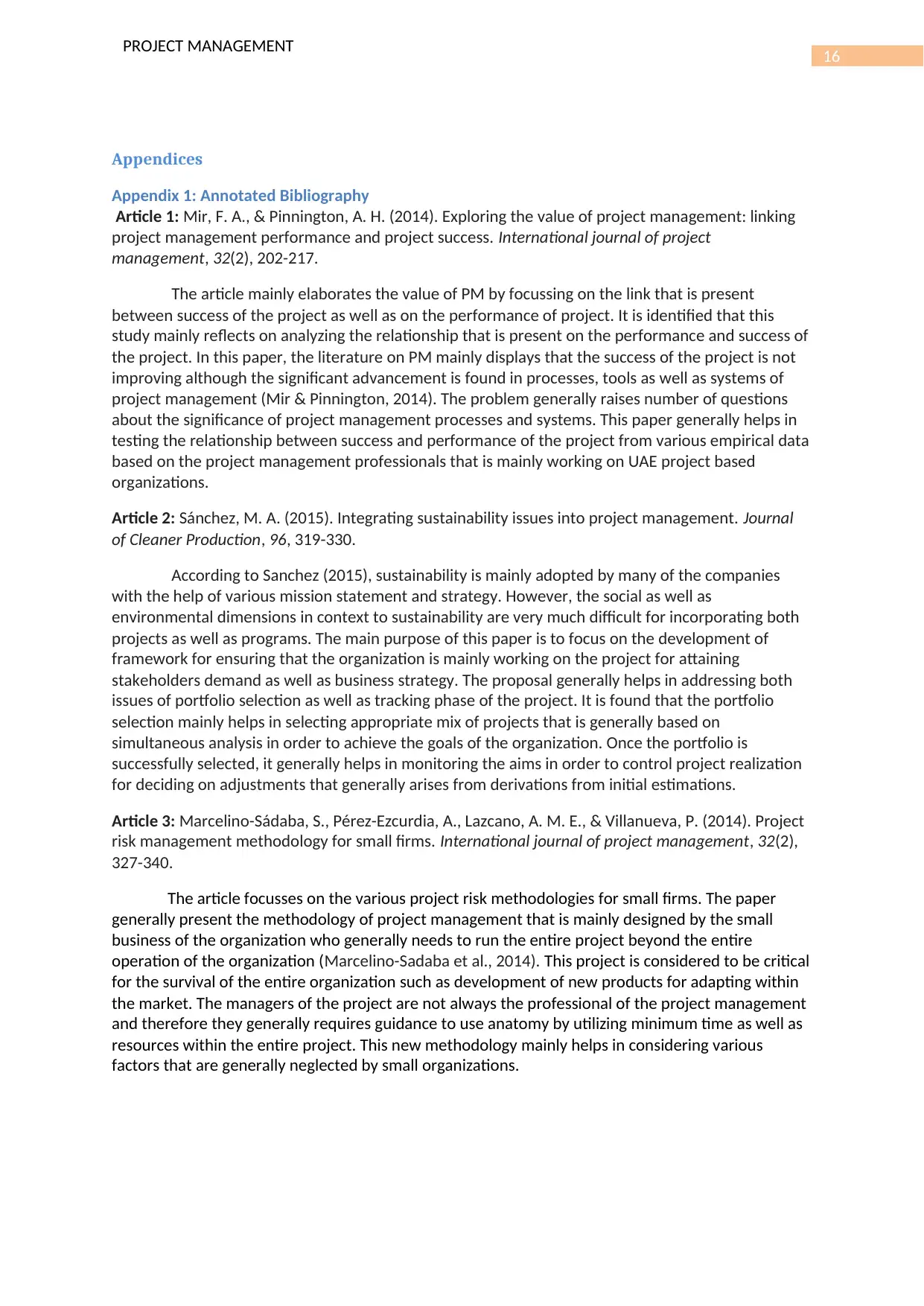
16
PROJECT MANAGEMENT
Appendices
Appendix 1: Annotated Bibliography
Article 1: Mir, F. A., & Pinnington, A. H. (2014). Exploring the value of project management: linking
project management performance and project success. International journal of project
management, 32(2), 202-217.
The article mainly elaborates the value of PM by focussing on the link that is present
between success of the project as well as on the performance of project. It is identified that this
study mainly reflects on analyzing the relationship that is present on the performance and success of
the project. In this paper, the literature on PM mainly displays that the success of the project is not
improving although the significant advancement is found in processes, tools as well as systems of
project management (Mir & Pinnington, 2014). The problem generally raises number of questions
about the significance of project management processes and systems. This paper generally helps in
testing the relationship between success and performance of the project from various empirical data
based on the project management professionals that is mainly working on UAE project based
organizations.
Article 2: Sánchez, M. A. (2015). Integrating sustainability issues into project management. Journal
of Cleaner Production, 96, 319-330.
According to Sanchez (2015), sustainability is mainly adopted by many of the companies
with the help of various mission statement and strategy. However, the social as well as
environmental dimensions in context to sustainability are very much difficult for incorporating both
projects as well as programs. The main purpose of this paper is to focus on the development of
framework for ensuring that the organization is mainly working on the project for attaining
stakeholders demand as well as business strategy. The proposal generally helps in addressing both
issues of portfolio selection as well as tracking phase of the project. It is found that the portfolio
selection mainly helps in selecting appropriate mix of projects that is generally based on
simultaneous analysis in order to achieve the goals of the organization. Once the portfolio is
successfully selected, it generally helps in monitoring the aims in order to control project realization
for deciding on adjustments that generally arises from derivations from initial estimations.
Article 3: Marcelino-Sádaba, S., Pérez-Ezcurdia, A., Lazcano, A. M. E., & Villanueva, P. (2014). Project
risk management methodology for small firms. International journal of project management, 32(2),
327-340.
The article focusses on the various project risk methodologies for small firms. The paper
generally present the methodology of project management that is mainly designed by the small
business of the organization who generally needs to run the entire project beyond the entire
operation of the organization (Marcelino-Sadaba et al., 2014). This project is considered to be critical
for the survival of the entire organization such as development of new products for adapting within
the market. The managers of the project are not always the professional of the project management
and therefore they generally requires guidance to use anatomy by utilizing minimum time as well as
resources within the entire project. This new methodology mainly helps in considering various
factors that are generally neglected by small organizations.
PROJECT MANAGEMENT
Appendices
Appendix 1: Annotated Bibliography
Article 1: Mir, F. A., & Pinnington, A. H. (2014). Exploring the value of project management: linking
project management performance and project success. International journal of project
management, 32(2), 202-217.
The article mainly elaborates the value of PM by focussing on the link that is present
between success of the project as well as on the performance of project. It is identified that this
study mainly reflects on analyzing the relationship that is present on the performance and success of
the project. In this paper, the literature on PM mainly displays that the success of the project is not
improving although the significant advancement is found in processes, tools as well as systems of
project management (Mir & Pinnington, 2014). The problem generally raises number of questions
about the significance of project management processes and systems. This paper generally helps in
testing the relationship between success and performance of the project from various empirical data
based on the project management professionals that is mainly working on UAE project based
organizations.
Article 2: Sánchez, M. A. (2015). Integrating sustainability issues into project management. Journal
of Cleaner Production, 96, 319-330.
According to Sanchez (2015), sustainability is mainly adopted by many of the companies
with the help of various mission statement and strategy. However, the social as well as
environmental dimensions in context to sustainability are very much difficult for incorporating both
projects as well as programs. The main purpose of this paper is to focus on the development of
framework for ensuring that the organization is mainly working on the project for attaining
stakeholders demand as well as business strategy. The proposal generally helps in addressing both
issues of portfolio selection as well as tracking phase of the project. It is found that the portfolio
selection mainly helps in selecting appropriate mix of projects that is generally based on
simultaneous analysis in order to achieve the goals of the organization. Once the portfolio is
successfully selected, it generally helps in monitoring the aims in order to control project realization
for deciding on adjustments that generally arises from derivations from initial estimations.
Article 3: Marcelino-Sádaba, S., Pérez-Ezcurdia, A., Lazcano, A. M. E., & Villanueva, P. (2014). Project
risk management methodology for small firms. International journal of project management, 32(2),
327-340.
The article focusses on the various project risk methodologies for small firms. The paper
generally present the methodology of project management that is mainly designed by the small
business of the organization who generally needs to run the entire project beyond the entire
operation of the organization (Marcelino-Sadaba et al., 2014). This project is considered to be critical
for the survival of the entire organization such as development of new products for adapting within
the market. The managers of the project are not always the professional of the project management
and therefore they generally requires guidance to use anatomy by utilizing minimum time as well as
resources within the entire project. This new methodology mainly helps in considering various
factors that are generally neglected by small organizations.
1 out of 17
Related Documents
Your All-in-One AI-Powered Toolkit for Academic Success.
+13062052269
info@desklib.com
Available 24*7 on WhatsApp / Email
![[object Object]](/_next/static/media/star-bottom.7253800d.svg)
Unlock your academic potential
© 2024 | Zucol Services PVT LTD | All rights reserved.



